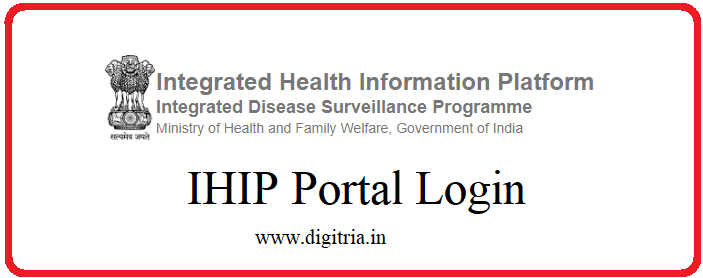IHIP Portal Login 2024 HMIS IDSP Login, ihip P form data entry

IHIP Portal Login: Integrated Health Information Platform (IHIP) under the guidance of the Ministry of Health and Family Welfare, the Government of India integrates all National health programs on a single platform. The Integrated disease surveillance programme is one such, to draw conclusions on the epidemic after surveillance of the disease.
National Health Program Initiates Program to Counter Epidemic Diseases National-wise:
1. The National Health Program initiated a surveillance system for epidemic-prone diseases whose timely detection can help save lives across the Nation.
2. The surveillance system will be state-based operating in a decentralization mode. On identification of the epidemic-prone diseases, the state can progress to take actions quickly and effectively with the available data.
3. The statistics of the epidemic spread over in every state shall be pooled-in to the center to generate complete data of the epidemic diseases.
4. If a problem is identified at the state level, a quick response to health challenges can be adopted to tackle such diseases.
5. To serve the purpose the central government created the integrated disease surveillance programme, IDSP.
IHIP Portal Login 2024 at www.ihip.nhp.gov.in:
1st Step: The user should visit the ihip login portal i.e. https://ihip.nhp.gov.in/idsp/#!/login.
2nd Step: The Users should enter the username, password, and captcha image in the box and click the sign-in button.

3rd Step: In case a user forgets the password then one should recover the password by checking the steps given below.
4th Step: The user must click the reset password link placed adjacent to the sign-in button. Or Call for 1-800-180-1134.

5th Step: The ihip login page shall lead to the next page like forgot password, and the user should enter the username in the column and click the submit button.

6th Step: The web portal shall lead to the next page, the user must follow the instructions to retrieve the secret code.
7th Step: A user can address their queries at the web portal’s helpdesk.
8th Step: Any enrolled user can enter the home page and click the helpdesk link placed on the top right corner of the web page.
9th Step: The hip portal shall display a help-desk sign page and one must enter the username, password, and enter the captcha image in the box, and click the sign-in button.
10th Step: The web portal shall take in the user to the concerned page to write down the query for a reply.
WHO Funds Integrated Disease Surveillance Programme:
The Central Government with the assistance of the World Bank launched Integrated Disease Surveillance Programme (IDSP) in 2004. The World Bank funds were extended for two years in March 2010, thus making it available from April 2010 to March 2012. The Funds for Central Surveillance Unit, CSU at NCDC and nine states were identified. They were Uttarakhand, Punjab, Maharashtra, Rajasthan, Gujarat, Tamil Nadu, Karnataka, Andhra Pradesh, and West Bengal and rest of the states and union territories were funded from the domestic budget.
Networking of the Surveillance Units (Center & States): Central Surveillance Unit, CSU is integrated into the National Center for Disease Control, Delhi. Inturn, the state surveillance, and district surveillance units lineup to the Central Surveillance Unit.
Project Analysis on Epidemic Outbreak:
The Integrated Disease Surveillance Program (IDSP) prepared surveillance standards (minimum datasets) for diseases in association with the National Center for Disease Control (NCDC) and submitted to WHO for approval and the same was finalized on 2nd May 2017. About 90 experts participated in the workshop and a laborious exercise consisted of reviews, discussions, and conclusions of Minimum datasets.
1. Essential data on the epidemic-prone disease is collected from various sources and a weekly report on the disease surveillance is conducted.
2. The data is picked from the sub centres like primary health cares, community health centres, hospitals (Government & private) inclusive.
3. The sample collections contain a systematic approach, a standard case, the data belongs to Syndromic, ‘S,’ probable, ‘P,’ and laboratory, ‘L.’
4. Every district must report weekly data via Email / portal (www.idsp.nic.in).
5. At the district, state and centre levels, the collated data is analysed to check the trend-set of the disease.
6. If the trend appears abnormal on investigation through RRT, immediately appropriate preventive measures are taken to control the state of outbreak.
Also Check: RCH Data entry Portal Login
